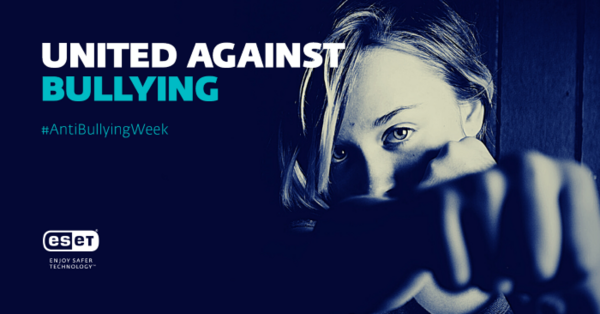Anti-Bullying Week, an annual campaign that aims to combat bullying and abuse at school, is running from Monday 16th November to Friday 20th November this year. Anti-Bullying Week is organised by the Anti-Bullying Alliance, and this year’s theme is “United Against Bullying,” encouraging teachers, parents, and caregivers to emphasise the power that people can have when they come together to tackle a challenge such as bullying.
Bullying is defined as the repetitive, intentional hurting of one person or group by another person or group, and preventing it has always been a difficult task, as it can be tricky to spot the signs early. However, this has become even more challenging since the advent of smartphones. While abuse was previously limited mostly to school hours, instant messaging and social networks now mean that bullying can spill over into children’s leisure time at home.
This was one of the principal reasons that ESET set up Safer Kids Online, a platform that compiles advice on how to stay up to date with the ever-changing online world. The mission is to build a safer online environment by educating children, parents and teachers about cybersecurity.
As highlighted by this year’s Anti-Bullying Week campaign, bullying is not a problem that can be solved by individuals – it is crucial that we all work together. Unlike bullying in the real world, cyberbullying can happen anywhere and at any time, through phones, computers and game consoles.
It is therefore important for parents and teachers to be educated on how to spot red flags when it comes to cyberbullying. Unfortunately, it can be difficult to distinguish common teenage issues from those arising from cyberbullying, but this article from Safer Kids Online highlights the red flags that you can look out for, including:
- Visible physical changes
- Sudden mood changes or loss of interest in normal activities
- Pretending to be sick to avoid school
- Deleting social network profiles
- Abnormal social withdrawal
- Belongings getting “lost” or damaged
If a child is displaying these signs, it is worth sitting down and asking them whether they feel that they are being targeted by bullies online. It is important to make sure that they know that they can confide in you without feeling threatened or judged, and that you are there to help them resolve the issues that they are experiencing.
Once you know what the issue is, you can then give clear advice on how to solve it. The first step is to demonstrate how to deal with a digital bully, for example by using the block and report features that are provided by social networks and online platforms. Next, discuss the importance of privacy awareness – explain why they should not talk to users they do not know in real life. Children should not interact with strangers, and their profile should only be visible to their friends – for more detailed advice on social media, check out this Safer Kids Online article.
Lastly, technology can also help keep children safe when they are using their mobile device. ESET Parental Control is a family-friendly app that allows parents to manage the online safety of their kids and prevent future problems from arising. It comes with features such as Web Guard and Safe Search, which control which content is displayed on the device, and Application Guard, which helps parents manage which apps kids spend time on.
If you would like to learn more about how to protect children online, including in-depth guides on issues such as social media, articles with advice for parents, and interactive videos for kids, head over to the Safer Kids Online site for much more information.
